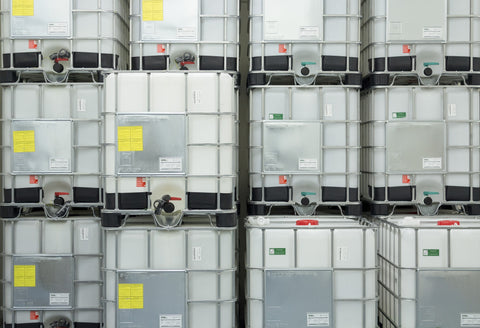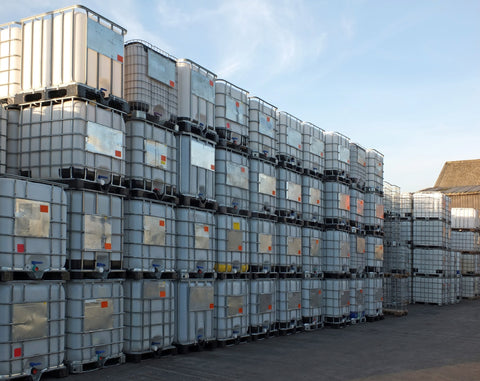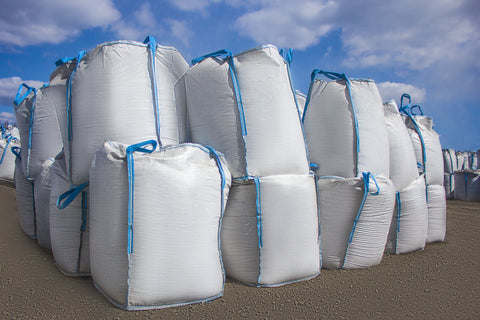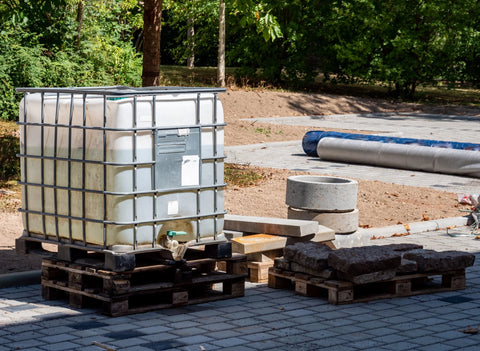Navigating PSI: A Critical Aspect of IBC Tote Usage
Intermediate Bulk Containers (IBCs) are vital for transporting and storing liquids, solvents, and granulated materials, combining high-density polyethylene (HDPE) durability with steel cage reinforcement. The focus on pounds per square inch (PSI) is crucial for ensuring the safety and integrity of these containers under pressure. Most of these containers are not built to be pressurized vessels, but some more specialized totes have been designed to handle higher amounts of PSI. Their design meets technical demands and enhances supply chain efficiency and safety, making PSI understanding key to optimizing IBC tote usage.
PSI and Its Impact on IBC Tote Integrity
PSI, or pounds per square inch, is a unit of pressure used to gauge the internal pressure levels that a tote can safely withstand. Understanding PSI is crucial for ensuring the safety and integrity of the container during storage and transport. This measure helps prevent overpressure situations that could lead to tote failure, spills, and potential harm. This article has been written to address the common question of how much or how many psi can an IBC tote hold. Mastery of PSI dynamics is instrumental in averting situations where excessive pressure could precipitate tote failure, resulting in spills or other hazardous incidents. This discourse aims to demystify the often-queried capacity of IBCs to hold specific PSI levels, ensuring stakeholders can make informed decisions regarding their use and application. Understanding these pressure capacities is vital for risk management and maintaining the safety standards for handling and transporting sensitive or hazardous materials.

The Role of Materials in Tote Durability and Pressure Resistance
The choice of material in the construction of IBC totes significantly affects their durability and pressure resistance. High-density polyethylene (HDPE) is prized for its strength, resilience, and flexibility. It offers excellent chemical resistance and is often UV stabilized to prevent degradation from sunlight—essential features for storing and transporting chemicals safely. Additionally, the compatibility of the tote material with stored substances is paramount to prevent chemical reactions and ensure the container's integrity.
Pressure Challenges and Solutions for IBCs
Navigating the pressure dynamics associated with IBCs demands innovative solutions to mitigate internal and external pressures. The internal generation of gases from chemical reactions and the external forces exerted during transportation pose significant challenges. Integrating gravity feed systems offers a natural solution to manage flow and pressure, leveraging the Earth's gravity to regulate content movement. Simultaneously, the strategic use of pressure washers and direct drive pumps facilitates meticulous cleaning and precise filling operations, ensuring pressure within the tote is managed effectively. These measures are paramount in maintaining the tote's integrity and operational efficiency, thereby preventing overpressure scenarios and ensuring the safety of both the product and the handlers.

IBC Designs and Safety Features
The diversity in IBC tank designs, exemplified by models such as "ultratainer" IBCs from companies like Snyder Industries, caters to a broad spectrum of materials and use-case scenarios. These designs are not merely aesthetic but functional, incorporating safety features that are critical to the tote's performance and compliance with regulatory standards. Vents for pressure regulation, secure lids for containment, and protective cages for structural integrity are just a few of the safety-oriented features that these totes boast. These elements are indispensable in ensuring that IBC totes can withstand the physical and environmental stressors they encounter while also preventing contamination and leaks. The thoughtful integration of these features underscores the commitment to safety and efficiency in designing and using IBCs, making them a reliable choice for transporting and storing a wide array of substances.
What is the maximum pressure for an IBC tank? How many PSIs can an IBC Tote Hold hold?
The ability of a tote to withstand pressure is a nuanced aspect that hinges on several critical factors, including its construction, design, and the materials used in its manufacture. Typically, a standard IBC tank is engineered to safely manage a certain threshold of pressure, expressed in pounds per square inch (PSI). This threshold is meticulously determined by manufacturers, considering the unique material properties of the tote and its designated applications. The specific gravity of the substances it is intended to hold, coupled with environmental factors like temperature fluctuations, significantly influences the maximum pressure an IBC tank can endure without compromising safety or integrity. For instance, totes designed for dense liquids or those subjected to higher temperatures may require specialized designs to manage increased internal pressures.
Chemical Handling and Storage in IBCs
Safe chemical handling and storage are critical considerations when using IBC totes. The chemical compatibility of the tote material with the stored chemicals ensures safety and integrity. Common chemicals require specific storage conditions, such as temperature control and protection from direct sunlight, to prevent adverse reactions and ensure safe handling. This compatibility extends beyond mere chemical resistance; it encompasses considerations for UV protection and temperature stability, ensuring that the stored chemicals are not compromised. The safe storage of chemicals also necessitates adherence to specific conditions, including temperature regulation and shielding from direct sunlight, to forestall the degradation of chemicals and container materials alike.
Optimizing Liquid Transfer: Pumps, Hoses, and the Science of Gravity
In the realm of IBC tank usage, the efficiency of liquid transfer—whether filling, dispensing, or managing contents—relies heavily on a symbiotic relationship between several key components: pumps, hoses, and the application of gravity. Understanding the interplay of these elements can significantly enhance operational efficiency and safety.

The Crucial Role of Pumps and Hoses
Pumps, serving as the heart of the liquid transfer system, are selected based on the nature of the liquid (including its specific gravity), the required transfer rate, and the pressure necessary to move the liquid through the system. The hose, akin to the circulatory system, must be compatible with both the pump and the liquid to ensure a seamless and efficient transfer. The specific gravity of the liquid—a measure of its density relative to water—dictates the type of pump needed; heavier liquids require pumps capable of generating higher pressure to overcome the gravitational pull.
The selection of a hose is equally critical. It must not only withstand the pressure generated by the pump but also resist the chemical properties of the transferred liquid. Easy connections between the pump, hose, and IBC tote facilitate a smooth operation, reducing downtime and minimizing the risk of leaks or spills.
Leveraging Gravity in Liquid Transfer
Gravity plays a pivotal role in the efficiency of liquid transfer operations. By positioning the IBC tote above the ground level, gravity can aid in the dispensing process, reducing the demand on the pump and conserving energy. This method, known as gravity feed, is particularly effective for operations where the differential height between the tote and the receiving container allows for a natural flow of liquid, minimizing the need for mechanical pumping.
The difference in elevation between the tote and the destination point can significantly impact the flow rate. Understanding this principle allows operators to optimize the setup for maximum efficiency, utilizing gravity to their advantage whenever possible.
Ensuring a Tight Seal: The Importance of Lids and Air Vents
A secure lid on the IBC tote is crucial for preventing contamination and evaporation, while air vents are necessary to equalize pressure during filling and dispensing. The presence of air vents ensures that a vacuum does not form inside the tank, which could hinder the flow of liquid and potentially damage the tank or pump system.
The 275-Gallon Standard and Its Implications
The 275-gallon IBC tote is a common standard within the industry, offering a balance between capacity and manageability. This tank size is particularly favored for its compatibility with a wide range of pump systems and its suitability for various applications, from agricultural chemicals to industrial solvents. The capacity of these totes necessitates careful consideration of the pump and hose specifications to handle the volume efficiently, especially when dealing with liquids of different specific gravities.
Tips for Maintaining Your IBC Tote
Regular maintenance is crucial for the longevity and optimal performance of IBC totes. This involves routine inspections for signs of wear, timely cleaning to prevent contamination and the verification that components such as valves and lids are functioning correctly. Such diligence in maintenance and cleaning not only prolongs the life of the tote but also ensures the safety and efficiency of its operation, minimizing the risk of leaks, spills, or other failures that could compromise safety or productivity.
Final Thoughts: Making the Right Choice for Your Needs
Selecting the appropriate IBC tote for your specific requirements demands a thorough evaluation of several factors. This includes the nature of the material to be stored or transported, the environmental conditions the tote will be exposed to, and the specific handling needs of your operation. By carefully assessing these considerations, you can choose an IBC tote that aligns with your capacity and pressure requirements, ensuring a solution that provides safety, efficiency, and reliability in your storage and transport operations. This informed decision-making process is instrumental in optimizing your supply chain and operational efficiencies, underscoring the importance of selecting the right container for your needs.







